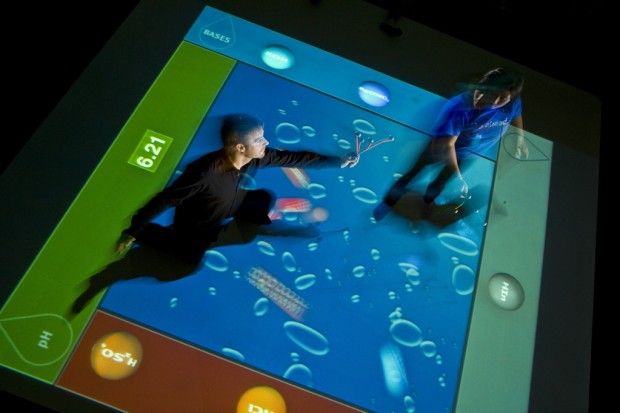
By Andrew Miller
"Embodied learning" is a new initiative in the field of interactive and game-based learning, in which learning content is combined with physical movement. Among one of the leading organizations in bringing this movement to the classroom is SMALLab, based in Los Angeles. The company has created activities -- check out their different learning scenarios -- that use large projected environments as experimental playgrounds of movement connected to learning targets.
For example, in one activity, students are put into “acids” and “bases” teams to experiment with molecules in a “virtual flask.” Students can add different molecules to the flask to see how their choices affect the simulated environment by using a “glowball” that contains color LEDs. The experiment, as described in a research brief, should show that, “as particles in the flask collide with each another, they undergo one of four reactions based on the general properties of acid and base in aqueous solution.” Here, the movement is necessary to experiment with the creation of acids and bases.
In another example, students explore concepts in earth science, such as the geological layer cake, and use the glowball and other controllers to experiment with placing fossils in different layers of the earth in different environments, from swamps to mountains.
Schools can use the products in two ways, SMALLab and Flow, for a range of topics and grade levels, including sciences, English language arts, and the performing arts. With Flow, teachers can use an existing Interactive Whiteboard or any project surface along with Microsoft’s Kinect motion-capture camera. For schools that use SMALLab equipment, "there are 12 motion-capture cameras to track students’ movements as they learn in an immersive, interactive space. For example, in the Constant Velocity Scenario, physics students can hear the sounds of their actions getting faster, see graphs that change in real time, and feel how their bodies move through the space." Its open-source software development kit allows schools to create new scenarios.
Why go through such lengths to teach this material? According to brain-based learning advocates, evidence supports the notion that the work in embodied learning can lead to increased student achievement. John Medina author of Brain Rules, claims that exercise boosts oxygen-rich blood flow to the brain, which helps students concentrate better in school.
In their own research conducted in K-12 schools and museums across the country, SMALLab found that “student learning gains were significantly higher after the SMALLab learning intervention when compared to regular classroom instruction.” In some instances, the company says it found that "there is a marked increase in the number of student-to-student and student-discussions during SMALLab."

